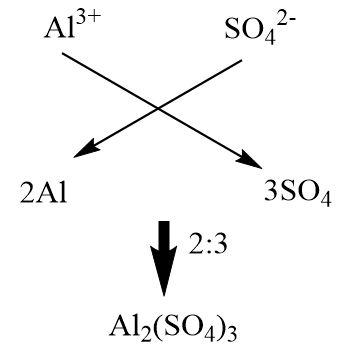
What is the chemical formula of Aluminium sulphate?
Answer
417.6k+ views
Hint: Ionic compounds consist of ions but the overall compound has to be neutral, therefore the crisscross charge balancing method should be used to ensure the overall neutrality and determine the formula of aluminium sulphate.
Complete answer:
Aluminium sulphate is an ionic compound consisting of Aluminium cations and sulphate anions. Its molecular formula can be determined by the crisscross method of balancing charge.
The crisscross method is a method used for balancing the charge of an ionic compound by interchanging the charge numbers of reacting ions with the number of ions needed to form a neutral compound.
Aluminium belongs to the thirteenth group of the modern periodic table and has a total of three valence electrons. Due to its electropositive nature it is capable of giving away all the three valence electrons and acquiring a positive charge of magnitude
Sulphate is a divalent anion that accepts two electrons from the metal it is attached to.
In order to balance the charges, we need to make sure that the product of the number of cations in a molecule and its charge is equal to the product of the number of anions in the molecule and its charge.
Therefore in the crisscross method, the charge on anion determines the number of cations in the molecule and the charge on cation decides the number of anions in the molecule and then the numbers are reduced to the simplest ratio possible.

Hence, the formula of Aluminium sulphate is
Note:
The six water molecules written separately after a dot in the chemical formula of Carnallite represent the water of hydration or crystallization. This indicates that each crystal contains a total of six water molecules trapped inside the crystal along with the salts present in it.
Complete answer:
Aluminium sulphate is an ionic compound consisting of Aluminium cations and sulphate anions. Its molecular formula can be determined by the crisscross method of balancing charge.
The crisscross method is a method used for balancing the charge of an ionic compound by interchanging the charge numbers of reacting ions with the number of ions needed to form a neutral compound.
Aluminium belongs to the thirteenth group of the modern periodic table and has a total of three valence electrons. Due to its electropositive nature it is capable of giving away all the three valence electrons and acquiring a positive charge of magnitude
Sulphate is a divalent anion that accepts two electrons from the metal it is attached to.
In order to balance the charges, we need to make sure that the product of the number of cations in a molecule and its charge is equal to the product of the number of anions in the molecule and its charge.
Therefore in the crisscross method, the charge on anion determines the number of cations in the molecule and the charge on cation decides the number of anions in the molecule and then the numbers are reduced to the simplest ratio possible.

Hence, the formula of Aluminium sulphate is
Note:
The six water molecules written separately after a dot in the chemical formula of Carnallite represent the water of hydration or crystallization. This indicates that each crystal contains a total of six water molecules trapped inside the crystal along with the salts present in it.
Recently Updated Pages
Master Class 11 Economics: Engaging Questions & Answers for Success

Master Class 11 Business Studies: Engaging Questions & Answers for Success

Master Class 11 Accountancy: Engaging Questions & Answers for Success

Master Class 11 English: Engaging Questions & Answers for Success

Master Class 11 Computer Science: Engaging Questions & Answers for Success

Master Class 11 Maths: Engaging Questions & Answers for Success

Trending doubts
Which one is a true fish A Jellyfish B Starfish C Dogfish class 11 biology CBSE

State and prove Bernoullis theorem class 11 physics CBSE

1 ton equals to A 100 kg B 1000 kg C 10 kg D 10000 class 11 physics CBSE

In which part of the body the blood is purified oxygenation class 11 biology CBSE

One Metric ton is equal to kg A 10000 B 1000 C 100 class 11 physics CBSE

Difference Between Prokaryotic Cells and Eukaryotic Cells




